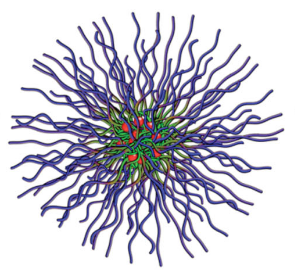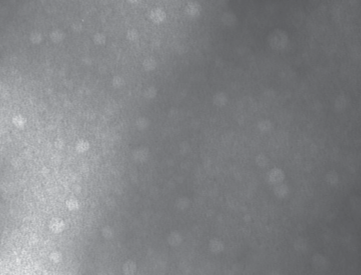Nontoxic, traceable nanoparticles may be the next weapon in cancer treatment
March 8, 2013

Theranostic nanoparticles (hydrophobic segments are visualized in green and hydrophilic segments in blue) (credit: Christian Porsch et al./Particle & Particle Systems Characterization)
Swedish scientists have developed “theranostic” (having both a therapeutic and diagnostic function) nanoparticles that can carry cancer drugs to tumor cells without toxicity and are biodegradable and traceable (can be seen in MRI images).
The nanoparticles were developed by a team including KTH Royal Institute of Technology Professor Eva Malmström-Jonsson, from the School of Chemical Science and researchers at Sweden’s Chalmer’s University and the Karolinska Institute in Stockholm.
Doxorubicin (DOX), one of the most commonly used chemotherapeutics in the clinic, is employed to treat many different types of cancer, including bladder, lung, ovarian and breast cancer. However, similar to many other anti-cancer drugs, DOX has severe issues with toxicity,and can cause cardiac damage.
The method makes nanoparticles spontaneously build themselves up using customized macromolecules. The formation requires a balance between the particle’s hydrophilic (capable of dissolving in water) and hydrophobic (not dissolvable in water) parts. The hydrophobic portion makes it possible to fill the particle with the drug.
A relatively high concentration of the natural isotope 19F (fluorine) makes the particles clearly visible on high-resolution images taken by MRI (magnetic resonance imaging). By following the path of theranostic nanoparticles in the body, it is possible to obtain information about how the drug is taken up by the tumor and whether the treatment is working.

Images of nanoparticles with DOx anti-cancer drug. Scale bar = 100 nm. (Credit: Christian Porsch et al./Particle & Particle Systems Characterization)
The scientists filled nanoparticles with the chemotherapy drug doxorubicin (DOX), which is used to treat bladder, lung, ovarian and breast cancer. In experiments on cultured cells, they showed that the particles themselves are not harmful but can effectively kill cancer cells after being loaded with the drug.
Targeting difficult-to-treat tumors
The next step is to develop the system to target tumors that are difficult to treat with chemotherapy, such as brain tumors, pancreatic cancer, and drug-resistant breast cancer tumors.
“By targeting groups on the surface, or by changing the size or introducing ionic groups on our nanoparticles, one can increase the selective uptake in these tumors,” says Andreas Nystrom, an associate professor of nanomedicine at the Swedish Medical Nanoscience Center and Department of Neuroscience, Karolinska Institute.
In the long term, the research can result in tailored chemotherapy treatments that seek out tumor cells. This would enable the toxic drug to be delivered more specifically to the tumor, making the treatment more effective while reducing side effects.
“What we want to do is try to give nanoparticles a homing function on the surface so that the drug is as effective as possible and can be transported to the right place,” Malmström-Jonsson says.
The study is funded in part by two grants from the Swedish Research Council to Andreas Nystrom and Eva Malmström-Jonsson. Malmström-Jonsson and Nystrom are also active in the company Polymer Factory Sweden AB.